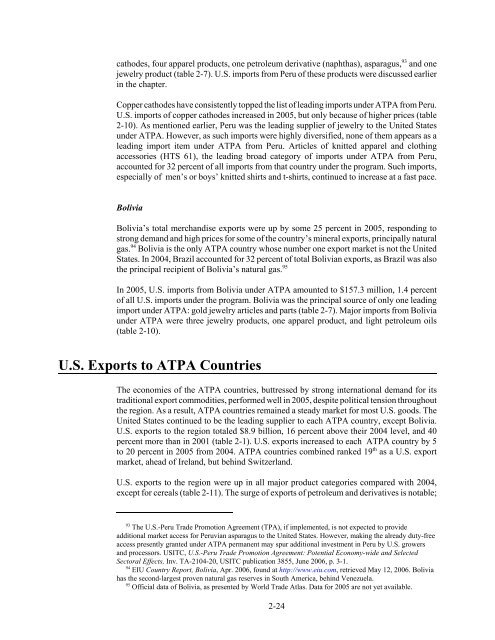The Impact of the Andean Trade Preference Act Twelfth ... - USITC
The Impact of the Andean Trade Preference Act Twelfth ... - USITC
The Impact of the Andean Trade Preference Act Twelfth ... - USITC
- No tags were found...
Create successful ePaper yourself
Turn your PDF publications into a flip-book with our unique Google optimized e-Paper software.
cathodes, four apparel products, one petroleum derivative (naphthas), asparagus, 93 and onejewelry product (table 2-7). U.S. imports from Peru <strong>of</strong> <strong>the</strong>se products were discussed earlierin <strong>the</strong> chapter.Copper cathodes have consistently topped <strong>the</strong> list <strong>of</strong> leading imports under ATPA from Peru.U.S. imports <strong>of</strong> copper cathodes increased in 2005, but only because <strong>of</strong> higher prices (table2-10). As mentioned earlier, Peru was <strong>the</strong> leading supplier <strong>of</strong> jewelry to <strong>the</strong> United Statesunder ATPA. However, as such imports were highly diversified, none <strong>of</strong> <strong>the</strong>m appears as aleading import item under ATPA from Peru. Articles <strong>of</strong> knitted apparel and clothingaccessories (HTS 61), <strong>the</strong> leading broad category <strong>of</strong> imports under ATPA from Peru,accounted for 32 percent <strong>of</strong> all imports from that country under <strong>the</strong> program. Such imports,especially <strong>of</strong> men’s or boys’ knitted shirts and t-shirts, continued to increase at a fast pace.BoliviaBolivia’s total merchandise exports were up by some 25 percent in 2005, responding tostrong demand and high prices for some <strong>of</strong> <strong>the</strong> country’s mineral exports, principally naturalgas. 94 Bolivia is <strong>the</strong> only ATPA country whose number one export market is not <strong>the</strong> UnitedStates. In 2004, Brazil accounted for 32 percent <strong>of</strong> total Bolivian exports, as Brazil was also<strong>the</strong> principal recipient <strong>of</strong> Bolivia’s natural gas. 95In 2005, U.S. imports from Bolivia under ATPA amounted to $157.3 million, 1.4 percent<strong>of</strong> all U.S. imports under <strong>the</strong> program. Bolivia was <strong>the</strong> principal source <strong>of</strong> only one leadingimport under ATPA: gold jewelry articles and parts (table 2-7). Major imports from Boliviaunder ATPA were three jewelry products, one apparel product, and light petroleum oils(table 2-10).U.S. Exports to ATPA Countries<strong>The</strong> economies <strong>of</strong> <strong>the</strong> ATPA countries, buttressed by strong international demand for itstraditional export commodities, performed well in 2005, despite political tension throughout<strong>the</strong> region. As a result, ATPA countries remained a steady market for most U.S. goods. <strong>The</strong>United States continued to be <strong>the</strong> leading supplier to each ATPA country, except Bolivia.U.S. exports to <strong>the</strong> region totaled $8.9 billion, 16 percent above <strong>the</strong>ir 2004 level, and 40percent more than in 2001 (table 2-1). U.S. exports increased to each ATPA country by 5to 20 percent in 2005 from 2004. ATPA countries combined ranked 19 th as a U.S. exportmarket, ahead <strong>of</strong> Ireland, but behind Switzerland.U.S. exports to <strong>the</strong> region were up in all major product categories compared with 2004,except for cereals (table 2-11). <strong>The</strong> surge <strong>of</strong> exports <strong>of</strong> petroleum and derivatives is notable;93 <strong>The</strong> U.S.-Peru <strong>Trade</strong> Promotion Agreement (TPA), if implemented, is not expected to provideadditional market access for Peruvian asparagus to <strong>the</strong> United States. However, making <strong>the</strong> already duty-freeaccess presently granted under ATPA permanent may spur additional investment in Peru by U.S. growersand processors. <strong>USITC</strong>, U.S.-Peru <strong>Trade</strong> Promotion Agreement: Potential Economy-wide and SelectedSectoral Effects, Inv. TA-2104-20, <strong>USITC</strong> publication 3855, June 2006, p. 3-1.94EIU Country Report, Bolivia, Apr. 2006, found at http://www.eiu.com, retrieved May 12, 2006. Boliviahas <strong>the</strong> second-largest proven natural gas reserves in South America, behind Venezuela.95 Official data <strong>of</strong> Bolivia, as presented by World <strong>Trade</strong> Atlas. Data for 2005 are not yet available.2-24
















